Portals to Mouros - Tracing Identity with Isaac Scott at Lucy Lacoste Gallery
Isaac Scott’s political mixed-media sculptures are on display at the Lucy Lacoste Gallery in Concord, Massachusetts from September 16 to October 14, 2023. Scott is a Philadelphia-based artist, curator, and photographer, whose provocative ceramics explore the lineage of the Slave Trade, the history of social, cultural, and racial exploitation, and how contemporary people and land carry the wounds of past generations' traumas.
In 2020, during the global pandemic, Scott, working primarily with clay, lost access to his studio and sublimated his artistic energy to taking photographs of his neighborhood in North Philly and the protests and marches on the streets following the death of George Floyd by the Minneapolis police.
In 2022, Scott traveled throughout Portugal during an artist residency where he (re)discovered that Lisbon, Portugal’s capital, was the city where the Slave Trade originated. Mouros, the title of his first solo exhibition, responds to his research and reflections on the Slave Trade—manifesting into six powerful stoneware and inkjet-printed Dibond pieces.
“Every now and then one comes across a new artist whose work excites and is worthy of the highest accolades. Realizing the content and the art in this completely new series, I knew I had to do everything possible to bring it to light in the fullest possible way.” - Lucy Lacoste
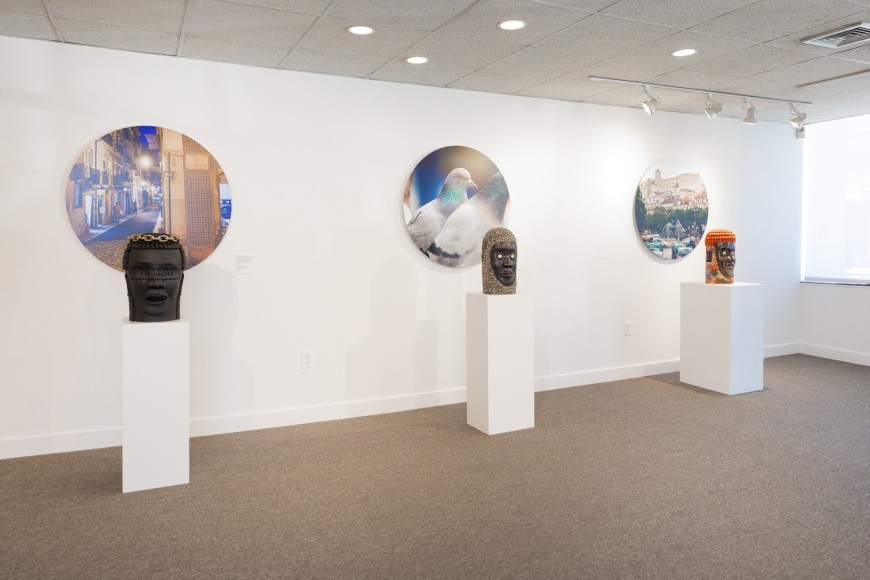
ILSY JEON (IJ): The inspiration behind your exhibition, Mouros, is rooted in your discovery and research on the Slave Trade and its origins in Lisbon, Portugal dating back to 1455. Can you describe the pivotal moment when you became aware of this history? Also, can you explain why you titled this show Mouros?
ISAAC SCOTT: When I arrived in Lisbon I was drawn to the older parts of the city. I immediately wanted to know more about the city's history. I learned about the African Lisbon Tour through my friends’ parents. The tour is organized and led by Naky Gaglo. That’s where I first learned about and experienced some of the places that I referenced in the exhibition.
The show title “Mouros”, translates to Moors in English. The title comes from a few different references. The first was the Moors who occupied the Iberian Peninsula from 711 to ~1249. Next, the people taken from the coast of West Africa who were called “Mouros” by the Portuguese. Lastly, the ancient myth of the Mouros from northern Iberia. This myth sometimes describes Mouros as Giant beings who collected treasures and lived underground.
I see my Mouros series as beings who dwell in different places that I visited on my travels through the country and they collect the stories of Africans who came through those locations throughout history.


IJ: The tragic death of George Floyd by the Minneapolis police, which you comprehensively documented, occurred just two years before your awareness of the Slave Trade in Portugal.
Considering the racial tensions in the US, how did it feel to conduct research in a foreign country and recognize that racism is pervasive in all lands? How has your research evolved to highlight your understanding and relationship to your ancestry, identity, and art practice?
ISAAC SCOTT: I’ve known for a long time that racism is pervasive throughout the world. We have seen Western colonization and the damage it has done throughout history. I think I had learned at some point that Portugal was the country to start the slave trade but it was never something that I thought much about until I was actually there.
One thing that stuck with me during my trip to Portugal, was how comfortable I felt. Here in the US, I feel like my identity, my race is something that is always looming over me. I never felt that way in Portugal. But when I talked to Afro-Portuguese about this, they explained to me how they face many of the same problems around race that we face in the US. And that the reason I felt so comfortable and welcomed in Portugal was because people recognized I was a tourist and they wanted my money. This hadn’t occurred to me because I’m used to people following me around stores because they assume I will steal something.
This made me think more about power dynamics here in the US around race. We in the black community are constantly reminded how we are not valued or appreciated for our essential contributions to the founding, growth, and success of this country.
Through my research, I found how the catholic church played such a major role in the start of the slave trade. It made me think of the parallels between protestant Christians in the US and how they used scripture to justify their use and dehumanization of African slaves in a “free” country. I also thought of how in both Portugal and the US, Africans used the church to free themselves and fight for their rights as human beings.
There is a bitter irony to the fact that the Africans who had their freedom, religion, and culture stripped from them by Christians, behave more like Christ than the Christians themselves.
I think about my own relationship with spirituality a lot. I grew up in a very religious household and was even confirmed Catholic. I’m not religious anymore but I do still feel a longing for some kind of spiritual practice that makes sense to me.
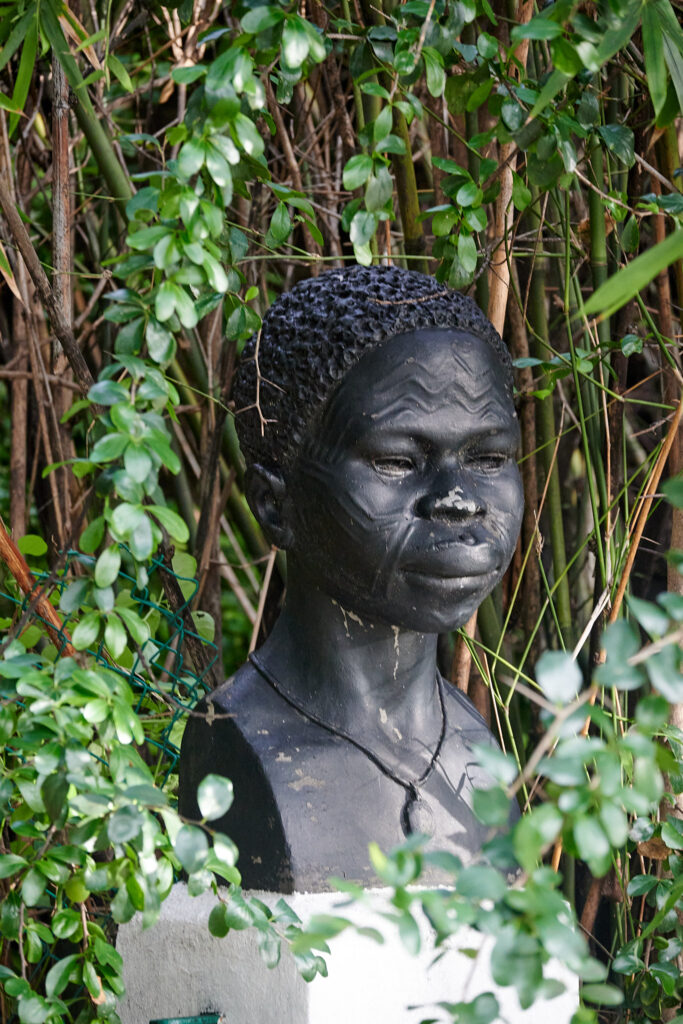

IJ: Your sculptures evidence extensive research about the Slave Trade and the history of the Moors during the Middle Ages. The photos you’ve taken are sites in Portugal that symbolically refer to the history of this region and the ceramic portraits beautifully respond to these images. Can you elaborate on your experience walking around Lisbon, conducting research, documenting, and taking photographs? How did you come to the decision to select the six photographs that are on display in relation to these particular busts?
ISAAC SCOTT: I was immediately in awe of the city. The ornate architecture, tiled walls and streets, the massive monuments, and marble sculptures all made for great photos. At first, I wasn’t sure how I would use the photos. I always have my camera on me when I travel, so taking photos as part of a sculpture or installation wasn’t my first intent. As I came up with my ideas around the Mouros heads and the narrative behind them, I felt that I should use the images to give more context to these locations. I felt the images and stories I made the work around were the ones I felt the most connection to personally.
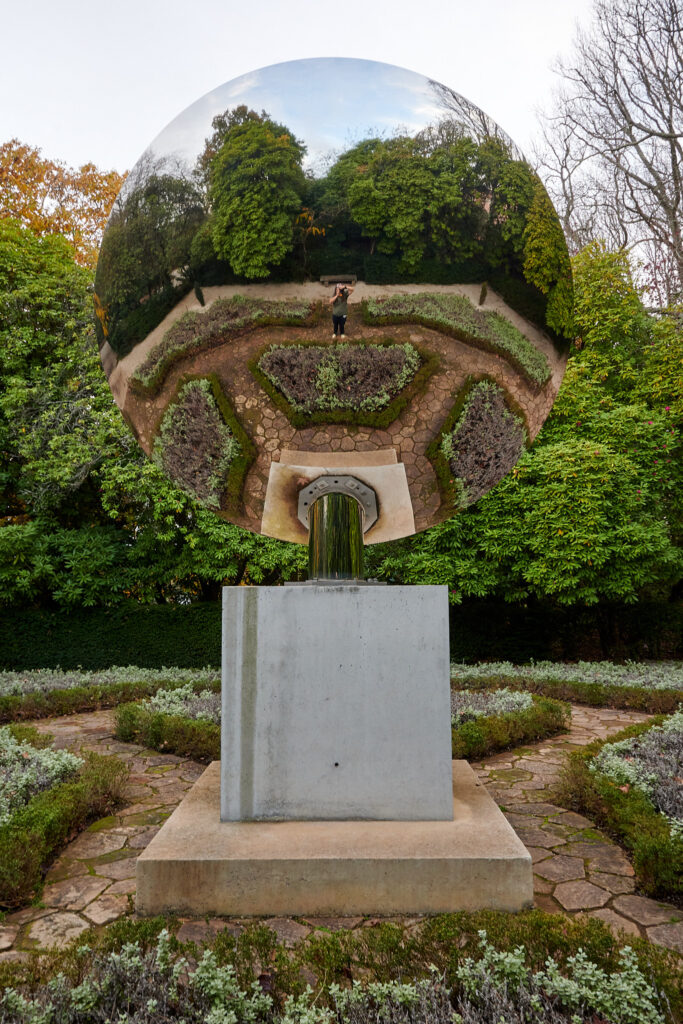
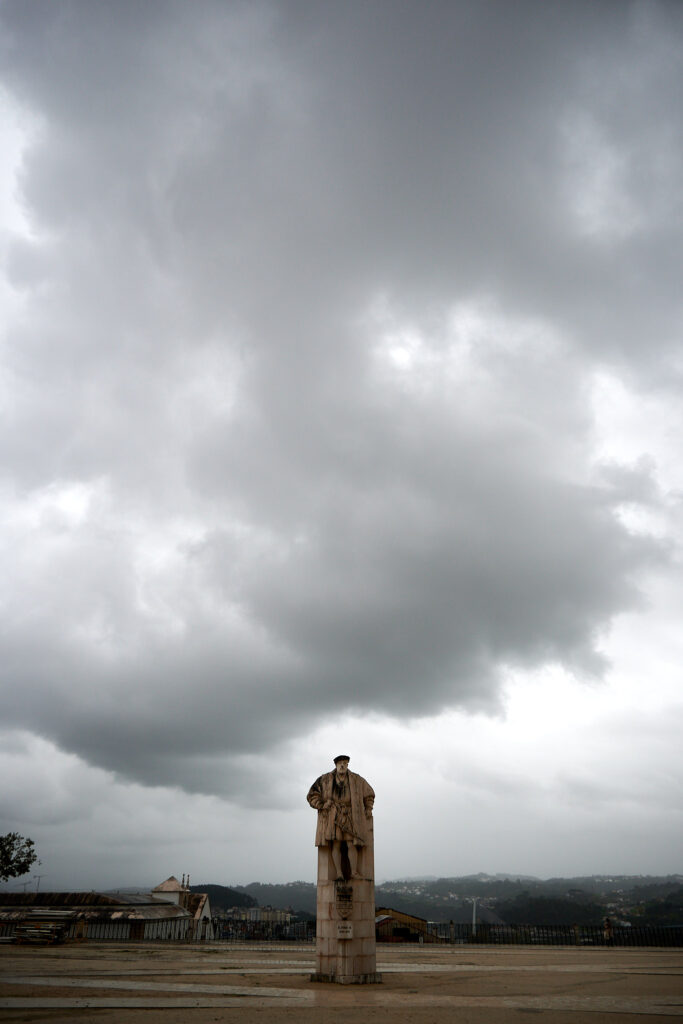
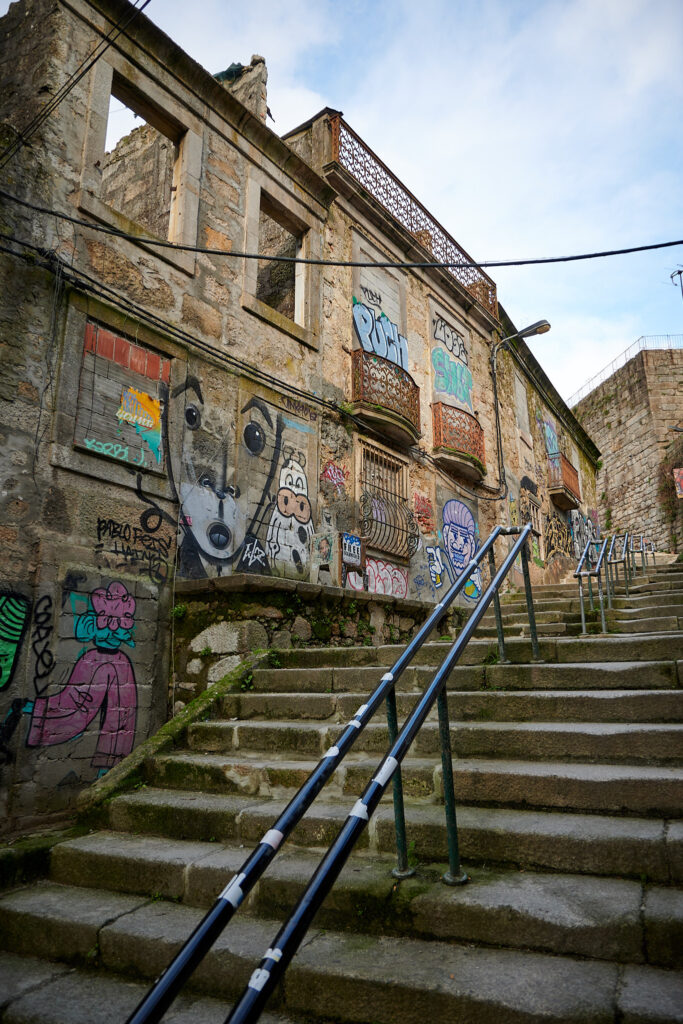
IJ: The ceramic heads depicting Black faces each have a distinct personality and characteristics that respond to their corresponding images. What was your approach and process for creating these ceramic portraits? Who are these people that you are paying homage to?
ISAAC SCOTT: I wanted to make portraits that fit the mood and energy of the stories connected to each piece. Some of them are more specific than others. The “Igreja de São Domingos“ piece has an expression of the figure singing. This comes from my connection of Black Spirituality to music as well as the hymns and chants that take place in a catholic mass. The expression of the “Mouro do Graffiti” speaks to the bravado and confidence in oneself that is celebrated in Hip Hop Culture.
I don’t see these sculptures as depicting anyone in particular.
IJ: Following up on the previous question: how has your research about the African diaspora and Hip-Hop culture influenced the formal and conceptual aspects and features of these ceramic forms?
ISAAC SCOTT: Something that I have focused on capturing in my work is the idea of resiliency. In both the Mouros series and past work around Philly, I have often used these motifs of decaying architecture paired with reference to monuments and vibrant colors.
I enjoy the duality in a form that is both broken yet exhibits strength and beauty.
In Hip Hop culture there is the idea of “making something from nothing” or creating value out of the scraps we find around us. I think the work I make is often a response to my own questions about having hope for the future. I see what many of my ancestors had to go through and how we got here. I think those stories give me hope for our generation to figure out the challenges in front of us.
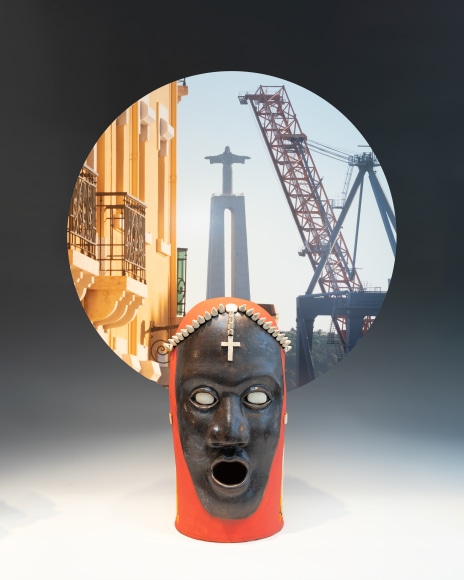
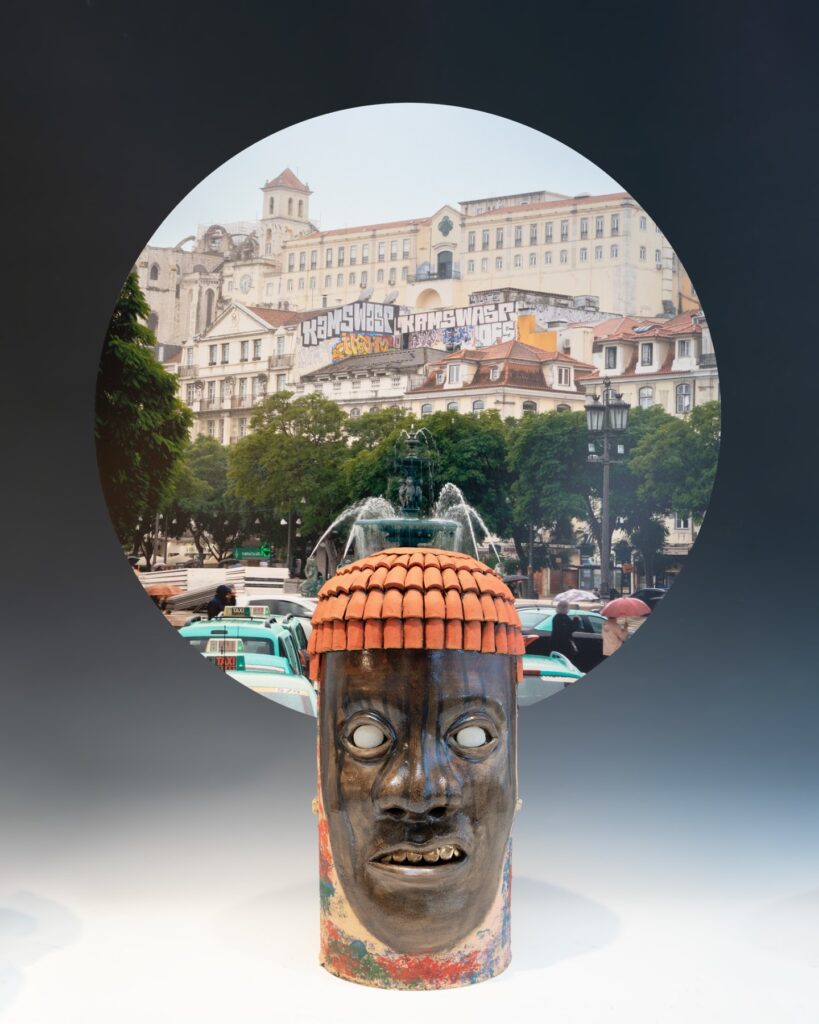
IJ: The way you’ve combined ceramic and photography is refreshing and avant-garde and is the perfect amalgamation of the two mediums you use to express your creativity. How did you come to the decision to integrate both mediums in this series and how did losing your studio during the pandemic act as an impetus to take up photography? Since returning to ceramics, after a few years of hiatus, how has your relationship with clay evolved?
ISAAC SCOTT: The photos in this series were important to add context to the heads I was making. They act as portals that bring the viewer to the exact place where these Mouros dwell. They also create halos around the heads, further pointing to the theme of Christian symbolism that runs through the show.
When I lost access to my studio during the pandemic I was taking a photography class so I ended up turning to photography as my source for creativity. It really got me out of the house and kept me sane during that time. Then when the BLM protests started I really got more serious about documenting what was happening around me.
Coming back to clay, I feel what happened in that summer of protests changed how I interact with the clay more than anything. The things I captured in the protests and the energy in those moments I began to express through the clay. Bringing both mediums together in different ways is exciting and gives me more options to bring my ideas to life.

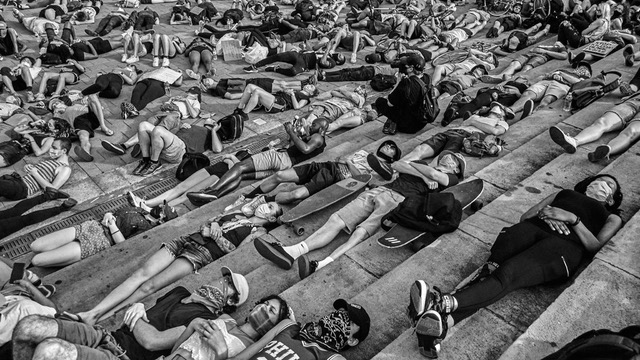

IJ: The art world has shifted dramatically in the last few years where history is being re-evaluated and re-visited from a post-colonial lens. Despite ceramics being globally practiced by all genders and races for centuries, you’ve noted how in the US, the ceramic field is a White space that is inaccessible to Black, Brown, and low-income communities.
How have you been navigating the predominately White spaces of clay and what challenges have you experienced? Have you seen sufficient progress in the American ceramic field within the last few years? Are there new artists or movements that inspire you?
ISAAC SCOTT: There are so many layers to this issue. In some ways, I have seen a lot of recent progress when it comes to the visibility and resources allocated to Black and Brown ceramic artists in the US. This has come from the rush institutions to Black and Brown artists after the summer of 2020. I am skeptical of this trend holding up though.
I think real progress only comes when there is a higher diversity of voices on boards of major art/craft institutions but also, and more importantly, institutions that are built, run, and owned by a diversity of voices. I have been serving on the Collaboration and Engagement Committee of NCECA’s Board for a few years now and I have gotten a better picture of why change is so slow to take place.
I think the things that excite me the most about the future of ceramics are organizers like Yinka Orafidiya, Osa Atoe, Ife Williams, Mapó Kinnord, and organizations like Kaabo Clay and The Color Network. These organizers and organizations have done amazing work in creating communities, resources, and opportunities for Black and Brown artists and artists of color.
IJ: You state how artists of color are “continually faced with the question of why ‘WE’ do what we do. […] It seems we are left to explain why ‘WE’ create what we create.”
Can you elaborate on what you mean by “WE” and how White ceramic artists aren’t subject to the same questions, prejudices, and mis- and pre-conceptions that artists of color face?
ISAAC SCOTT: When I say “WE” I mean people of color in general. Many minorities who have different racial and cultural identities are aware of how our identities are mixed up in the lens through which people see our work.
As I mentioned before there has been a trend of searching for Black and Brown artists among major art and craft institutions around the country since the murder of George Floyd. I have seen people's lives completely change during that time. It wasn't the artist's work that changed. Just the cultural relevance of the artist's identity.
I believe that many institutions made certain changes or created programming around DEI initiatives out of self-preservation and not from a sincere connection to those issues. As an artist of color, I am very aware of how my work and the lens people see my work is attached to my identity as a Black man. So often, when dealing with juries, applications, critiques, and museums, my work is viewed through the white lens.
I often feel, as do many artists of color I know, that this brings an extra level of explanation, education, and misunderstanding around my work, which is directly tied to my identity. However, when I share my work with the black community or with people who have a similar lived experience the nature of the conversation or the critique around the work shifts dramatically.



To learn more about Mouros at Lucy Lacoste Gallery, CLICK HERE
To explore the works of Isaac Scott, CLICK HERE
